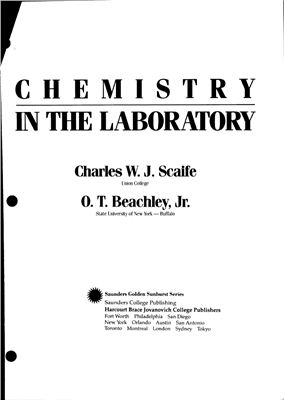Saunders College Publishing, 1987. – 594 p.
This book is designed to provide experiments for both a general chemistry course and for an inorganic chemistry course as covered either within general chemistry or as a separate course. This book has been written through the collaboration of two authors, one at a small, private, liberal arts college, and the other at a large, public, state university. They have taught general chemistry to a wide spectrum of college students ranging from nonscience majors in humanities and social sciences through science majors, engineers, and advanced placement chemistry majors. In the past, they have written laboratory experiments relating to a two-week laboratory experience for middle school students, a college laboratory course for nonscience majors, a laboratory manual for general chemistry, and both sophomore-level and senior-level inorganic chemistry courses. Thus, they brought extensive experience into their writing.
General instructions.
Safety precautions.
Laboratory methods.
Measuring Length.
Measuring Volume.
Measuring Mass.
Heating Materials.
Measuring Temperature.
Inserting Glass Tubing into Rubber Stoppers.
Transferring Liquids from Bottles.
Decanting Liquids.
Filtering and Washing Solids.
Centrifuging Solids.
Preparing Solutions.
Evaporating Liquids.
Drying Solids.
Bausch and Lomb Spectronic 20 Spectrophotometer.
Preparing Cold Baths.
Using Test Papers.
Measuring pH.
Experiments.
Manipulating Glass Tubing.
Density of a Solid.
Empirical Formula of a Compound.
Analysis of an Oxygen-containing Compound or Mixture.
Analysis of an Unknown Mixture by Fractional Crystallization . .
Analysis of the Reaction Products after Reacting Magnesium with Air.
Gravimetric Analysis of a Two-Component Mixture.
Analysis of an Unknown Mixture by Dehydration.
Analysis of an Unknown Mixture Using the Ideal Gas Law.
Molecular Weight of an Unknown Volatile Liquid.
Vapor Pressure, Boiling Point, and Heat of Vaporization of an Unknown Liquid.
Analysis of an Alloy.
Preparation of Alum.
Analysis of Alum.
Preparation and Analysis of an Iron Complex.
Preparation and Analysis of a Cobalt Complex.
Preparation and Analysis of a Copper Complex.
Crystal Structures and Close-packing of Spheres.
Solubility and Association of Ions.
Freezing-Point Depression and Molecular Weight.
Enthalpy Change of a Chemical Reaction.
Enthalpy, Entropy, and Free Energy Changes for a Chemical Reaction.
Chemical Kinetics.
Chemical Equilibrium.
Acid-Base Titration and Molecular Weightof an Unknown Acid.
Analysis of an Unknown Mixture by Acid-Base Titration.
Ionic Equilibria, pH, Indicators, and Buffers.
Solubility Product of CdC204 and Formation Constant of Cd(NH3)42+.
Galvanic and Electrolytic Cells.
Oxidation-Reduction Titration and Analysis of an Unknown Mixture.
Preparation of Aspirin, Determination of its Molecular Weight, and the Assay of Commercial Aspirin.
Polymers.
Stoichiometry of a Precipitation Reaction, an Oxidation-.
Reduction Reaction, and a Complexation Reaction.
Temporarily and Permanently Hard Water.
Boron and Its Compounds.
Aluminum and Aluminum Hydroxide.
Tin Compounds and Covalent Character.
Compounds of Nitrogen.
Halogens and Hydrogen Halides.
Chemistry of Copper and of Bromine.
Multiple Oxidation States of Transition Elements.
Identification of Inorganic Solids.
Separation and Identification of Cations.
Multi-Bottle Challenge.
This book is designed to provide experiments for both a general chemistry course and for an inorganic chemistry course as covered either within general chemistry or as a separate course. This book has been written through the collaboration of two authors, one at a small, private, liberal arts college, and the other at a large, public, state university. They have taught general chemistry to a wide spectrum of college students ranging from nonscience majors in humanities and social sciences through science majors, engineers, and advanced placement chemistry majors. In the past, they have written laboratory experiments relating to a two-week laboratory experience for middle school students, a college laboratory course for nonscience majors, a laboratory manual for general chemistry, and both sophomore-level and senior-level inorganic chemistry courses. Thus, they brought extensive experience into their writing.
General instructions.
Safety precautions.
Laboratory methods.
Measuring Length.
Measuring Volume.
Measuring Mass.
Heating Materials.
Measuring Temperature.
Inserting Glass Tubing into Rubber Stoppers.
Transferring Liquids from Bottles.
Decanting Liquids.
Filtering and Washing Solids.
Centrifuging Solids.
Preparing Solutions.
Evaporating Liquids.
Drying Solids.
Bausch and Lomb Spectronic 20 Spectrophotometer.
Preparing Cold Baths.
Using Test Papers.
Measuring pH.
Experiments.
Manipulating Glass Tubing.
Density of a Solid.
Empirical Formula of a Compound.
Analysis of an Oxygen-containing Compound or Mixture.
Analysis of an Unknown Mixture by Fractional Crystallization . .
Analysis of the Reaction Products after Reacting Magnesium with Air.
Gravimetric Analysis of a Two-Component Mixture.
Analysis of an Unknown Mixture by Dehydration.
Analysis of an Unknown Mixture Using the Ideal Gas Law.
Molecular Weight of an Unknown Volatile Liquid.
Vapor Pressure, Boiling Point, and Heat of Vaporization of an Unknown Liquid.
Analysis of an Alloy.
Preparation of Alum.
Analysis of Alum.
Preparation and Analysis of an Iron Complex.
Preparation and Analysis of a Cobalt Complex.
Preparation and Analysis of a Copper Complex.
Crystal Structures and Close-packing of Spheres.
Solubility and Association of Ions.
Freezing-Point Depression and Molecular Weight.
Enthalpy Change of a Chemical Reaction.
Enthalpy, Entropy, and Free Energy Changes for a Chemical Reaction.
Chemical Kinetics.
Chemical Equilibrium.
Acid-Base Titration and Molecular Weightof an Unknown Acid.
Analysis of an Unknown Mixture by Acid-Base Titration.
Ionic Equilibria, pH, Indicators, and Buffers.
Solubility Product of CdC204 and Formation Constant of Cd(NH3)42+.
Galvanic and Electrolytic Cells.
Oxidation-Reduction Titration and Analysis of an Unknown Mixture.
Preparation of Aspirin, Determination of its Molecular Weight, and the Assay of Commercial Aspirin.
Polymers.
Stoichiometry of a Precipitation Reaction, an Oxidation-.
Reduction Reaction, and a Complexation Reaction.
Temporarily and Permanently Hard Water.
Boron and Its Compounds.
Aluminum and Aluminum Hydroxide.
Tin Compounds and Covalent Character.
Compounds of Nitrogen.
Halogens and Hydrogen Halides.
Chemistry of Copper and of Bromine.
Multiple Oxidation States of Transition Elements.
Identification of Inorganic Solids.
Separation and Identification of Cations.
Multi-Bottle Challenge.

